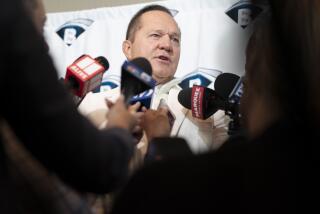Kemp Has Long and Winding Road Back : At 31, He Spends Prime of Career in Las Vegas, Victim of a Bad Eye and Arm
LAS VEGAS — It was nearly 110 degrees at Cashman Field when Steve Kemp ran out to left field to shag flies this Tuesday afternoon. His shoulder was tight, his elbow hurt and his palms were pink and blistered.
Unlike his teammates on the Las Vegas Stars, who had been playing baseball daily since March, Kemp was not in shape, and his body was letting him know it. Released by the Pittsburgh Pirates in April, he hadn’t touched a bat in nearly three months.
After laboring for more than an hour in the stifling heat, Kemp retreated to the cramped but air-conditioned clubhouse. He helped himself to oranges and watermelon provided for the players, then headed for the trainer’s room for therapy.
Barely a week had passed since he reported to the Stars, the Pacific Coast League affiliate of the San Diego Padres. Kemp was beginning an attempt to learn if he could still play the game that had made him a wealthy young man before branding him a has-been at age 31 this spring.
Kemp, who is in the fourth year of a guaranteed five-year contract worth $2.6 million, wasn’t expecting to play Tuesday night. He got very nervous when Manager Larry Bowa called upon him to pinch-hit in the sixth inning.
He walked to the on-deck circle for a couple of practice swings and tried to calm himself. “If you strike out, it’s no big deal,” he thought. “Just try to relax.”
Kemp knew little about the opposing pitcher, Jeff Heathcock of the Tucson Toros. His focus was more on the advice he recently got from Don Mattingly of the New York Yankees.
Kemp, whose home is in Laguna Niguel, had gone to an Angel game against the Yankees in June and had sought out his former teammate. Mattingly provided some technical insights on how to position the hands and shoulders squarely toward the pitcher.
There hadn’t been much time for rehearsals, but it didn’t matter.
Kemp swung at Heathcock’s first pitch and drove it high and deep to the opposite field. The ball landed on a grassy embankment beyond the fence in left-center for a three-run homer.
As he circled the bases, Kemp’s thoughts turned to his 2-year-old daughter and his recently deceased grandmother.
“My little girl, Stephanie, never saw me when I was going good,” Kemp said. “I want her to be able to watch her daddy and be proud of him as she grows up.”
Someone retrieved the home run ball and presented it to Kemp, who later gave it to Stephanie.
It would be nice to report that she had the ball in hand as she ran through the hotel lobby the next morning, but in truth she was carrying a “Muppet Babies” raft as her mother led her toward the pool.
Kemp was saddened that his grandmother had died only a few days earlier, but he wanted to believe she knew what he had done. “I think it kept her alive a few extra years following my career,” he said. “She was my biggest fan.”
It was only one swing in a minor league game, but it clearly had meaning for Kemp, whose 10-year career has included time with the Detroit Tigers and Chicago White Sox in addition to the Yankees and Pirates.
“I’m on a quest,” Kemp said. “Even if I never make it back to the major leagues, I’ll have the satisfaction of that home run on my first swing.”
His second evening with the Stars brought more satisfaction. Kemp collected three straight hits, two singles and a double, before Tucson got him out twice late in the game.
“Hey, that’s me, that’s the way I used to hit,” Kemp said, extending further credit to Mattingly for helping with his swing.
“After a few workouts here, my front shoulder was sore because I was trying to keep my hands positioned like Don said. Since my shoulder hurt, I knew I was doing something right. The last couple of years I had been pulling off the ball and striking out a lot, but now I’m hitting the ball to left and right center, the way I once did.”
It has been a long time since Kemp consistently hit the ball with power to all fields. No one, including Kemp, is predicting he will return to the level he reached in his mid-20s before injuries threatened his career.
His best years were with the Tigers. In 1979 he hit .318 with 26 homers and 105 runs batted in. The next season he batted .293 with 21 homers and 101 RBIs.
He was traded to Chicago in 1982 and became a free agent after hitting .286 with 19 homers and 98 RBIs. The Yankees awarded him a five-year contract worth more than $500,000 a year, but his time in New York was unpleasant.
He was forced to undergo surgery for a damaged retina late in 1983, and had an operation to repair a torn rotator cuff after the next season.
After being traded to Pittsburgh, he hit .250 with just two homers last year. The Pirates released him this spring after Kemp hit .188 in three games.
His comeback was launched in late June when the Padres began looking for a veteran outfielder to help their Triple-A farm team. San Diego General Manager Jack McKeon made no promises of future employment, but he gave Kemp an opportunity to play again.
“He needs a diet of regular play,” McKeon said. “We won’t be in a hurry to judge him. You never know what a guy might do. He used to be a real hitter.
“We didn’t take him with the stretch run in mind, but we could have an injury and (have available) a guy who’s been there. If we have no use for him, we surely wouldn’t try to stymie him. We like his attitude--he’s already been a good example for our young players in Las Vegas--and he’d only cost us $60,000 if we kept him next year.”
Kemp will become a free agent when the PCL season ends Sept. 1, according to his agent, Dick Moss. If the Padres are interested, Kemp probably would sign with them, but he would also be interested in the Tigers and Angels.
“He has to demonstrate he can play regularly,” Moss said. “Our plan is not to do much of anything for a while, just let him play without undue pressure. If he doesn’t do well, he’s prepared to retire. He wants to show others he can play, but mostly this comeback is to prove to himself if he can still perform.”
After a decade in the major leagues, Kemp had grown accustomed to going first class. It took only one day to get acquainted with life in the minors.
The Stars were in Albuquerque when Kemp joined the team. Outfielder Gary Woods, an ex-big leaguer himself, watched through the window of his hotel room as Kemp struggled with his luggage.
“It must have been about 120 degrees, and Steve was just sweating like a pig as he fought that big suitcase,” Woods said. “Hey, this is a tough league for bellmen.”
The meal money is $11 a day, and the travel is demanding. On a recent trip the Stars were up at 5:30 a.m. for a flight to Calgary, where they arrived at 3 p.m. for a game that night.
“You’re only a phone call away from the big leagues, but it can be a long haul,” Woods said. “It’s set up to be the survival of the fittest, and you just have to put your nose to the grindstone.”
Kemp seems willing to do so.
Recently he received a letter from a Detroit fan who said no one cared about him because he had no guts. “Man, that really bothered me,” Kemp said. “I don’t have to play any more baseball. I’m guaranteed my money. But I have enough guts to go to Triple-A. I’ve always been known as a player who would bust his butt on every play.”
There will be some embarrassing moments, no doubt. Kemp’s arm isn’t in shape, and no amount of hustle is going to overcome the limitations imposed by being two or three months behind other players.
“I don’t expect him to be throwing out runners at the plate,” Bowa said while hitting fungoes to Kemp.
“I know it’s going to be a gradual thing, but it would be eight weeks if we waited for him to be completely ready, and we don’t have that kind of time. His reflexes are there, and he’s physically strong.”
Bowa, in his first season as a manager, said he will be patient with Kemp’s mistakes. He seems to think it’s a mistake that Kemp is even in the minor leagues.
“What I can’t understand is how a guy sitting in an office can make decisions on whether a guy is washed up at 31,” he said. “Steve Kemp is at an age when he should be in the prime of his career, and I know he wants to prove he has a lot left.”
Chuck Tanner, who managed Kemp last year in Pittsburgh, said he never saw a player work any harder.
“Steve worked like a man in a coal mine,” said Tanner, now managing the Atlanta Braves. “Geez, I really admire him and respect him for what he’s doing now. If he’s OK physically, he’s got one of the most explosive bats around.”
The Pirates released Kemp this spring because of a youth movement that embraced promising outfielders such as Mike Brown, R.J. Reynolds, Barry Bonds and Joe Orsulak. Kemp thought Manager Jim Leyland wanted to keep him, but Leyland was overruled by the front office.
“Just from a practical business standpoint, the Pirates shouldn’t have released me,” Kemp said. “They should have played me some and traded me instead of just getting rid of my contract.”
If there is bitterness toward the Pirates, Kemp isn’t expressing it to teammates in Las Vegas.
“I think Steve realizes baseball is a tough business and there are no promises to anybody,” Woods said. “And he sure as hell realizes a lot of players have got it worse than he does.
“I know for sure he doesn’t feel any guilt about the money he’s getting. He’s earned every dime of it. Nobody ever says anything about all the years of work it takes to get to the major leagues. I know Steve feels in his heart, like every player, he deserves the money he’s making.”
The morning after his dramatic, first-pitch home run, Kemp returned to the ballpark for therapy on his aching body. Back at the hotel, his wife, Mary Jane, entertained Stephanie and talked about the setbacks they’ve endured.
After his release by Pittsburgh, Kemp had doubts about his future, and there was stress on the marriage, she said.
“The money is great, but we’ve had our share of heartaches,” Mary Jane said. “It was very hard on our relationship this spring. I was trying to keep Steve in an up mood, but I know what he was going through.
“There was a positive side to it, though. For the first time we had a chance to think about what we would do with the rest of our lives. And we even got to be normal people for a few months. I got to make dinner at 6, and we could go to sleep at 10, things you can’t do in a baseball season.”
She predicted her husband might again drive in 100 runs if he gets a chance to play every day. She said he can’t perform at his best on a platoon basis, and pinch-hitting makes him too nervous to even consider undertaking that role.
“What a lot of people don’t realize is the severity of the injuries Steve has had to overcome,” she said. “He had the same injury Dickie Thon had.”
In a batting practice accident three years ago, Kemp was struck in the face. He suffered a cut that required 21 stitches, a fracture of the cheekbone, and damage to the retina that required surgery. His vision, which had been 20/15 in the left eye, was only 20/50 after the operation, and it’s still in that range.
In order to see the ball more clearly, Kemp altered his stance in 1984. He had to turn his head slightly to face the pitcher, and he believes that may have been when he began “pulling off the ball,” the problem Mattingly tried to help correct last month.
The eye wasn’t his only problem. Kemp had an operation to repair a partial tear of the rotator cuff in his shoulder last year. He reported to spring training a month after surgery, and his arm wasn’t ready. Consequently, his statistics for 1985 were the poorest of his life.
The shoulder still requires daily attention, but Kemp believes it is nearly as strong as ever. He attributes some of the pain he has felt in his comeback to his long layoff.
“I’m not a religious person, but I think I’m being tested now,” Kemp said. “I think God took me away from baseball to help me get everything in perspective. I know I really needed to spend more time with my family, so it may have been a blessing in disguise when the Pirates released me.”
Kemp’s objective in Las Vegas is to regain his confidence and hit the ball well by the end of August. If that doesn’t happen, he said he may retire.
“My loyalty is to the Padres because they gave me a chance to play again and to be near my home,” he said. “I feel a special favoritism for the Padres, and if they could use me for 140 games (next year), that would be great. But they have said they have no firm plans for me, and I know they owe me nothing further.”
If his future isn’t in San Diego, it could be in the American League as a designated hitter. Or it could be in Japan. Kemp is flexible. He also has investments that would permit him to live comfortably if it develops that baseball has no further use for him.
“I’ve always loved baseball, and I don’t want go out with a sour taste in my mouth,” he said. “The game can be a real grind at times, but I think I can still enjoy it and have fun playing.
“I know people will be watching me, and some of them will expect something spectacular to happen. But, hell, even if I hit only .250, I would probably play another year of Triple-A ball if I’m swinging the bat well.”
More to Read
Go beyond the scoreboard
Get the latest on L.A.'s teams in the daily Sports Report newsletter.
You may occasionally receive promotional content from the Los Angeles Times.










